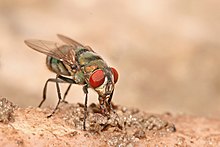Chrysomya
| Chrysomya | |
|---|---|
 |
|
| Chrysomya albiceps | |
| Scientific classification | |
| Kingdom: | Animalia |
| Phylum: | Arthropoda |
| Class: | Insecta |
| Order: | Diptera |
| Family: | Calliphoridae |
| Subfamily: | Chrysomyinae |
| Genus: |
Chrysomya Robineau-Desvoidy, 1830 |
| Species | |
|
See text |
|
See text
Chrysomya is an Old World blow fly genus belonging to the family Calliphoridae. The Chrysomya genus contains a number of species including Chrysomya rufifacies and Chrysomya megacephala. The term “Old World blow fly” is a derivative of both the associated family, Calliphoridae (blow flies), and the belief that the genus Chrysomya originated in Asia and migrated to North America only relatively recently. Chrysomya’s primary importance to the field of medico-criminal forensic entomology is due to the genus’ reliable life cycle, allowing investigators to accurately develop a postmortem interval. Chrysomya adults are typically metallic colored with thick setae on the meron and plumose arista.
Identification traits of the Chrysomya genus include:
Keep in mind, however, that not all species will conform completely to these guidelines. Adults feed on many things including decaying matter, excreta, and flowers. In their six-week lifespan, (specific length may differ as a result of temperature, weather, etc.) females lay egg masses typically consisting of 50-200 eggs. Different species within this genus exhibit varying egg laying procedures. The species Chrysomya bezziana, for example, lay their eggs exclusively on live mammals. In contrast, most Chrysomya species prefer to perform oviposition on dead organisms. And, as with many fly genera primary and secondary myiasis is possible but unlikely.
The genus Chrysomya contains 12 species, several of which cause primary and secondary myiases of domestic animals. The larvae of one species, Chrysomya rufifacies, have very distinct thorn-like processes covering its entire body, giving it the common name “hairy maggot blow fly”. The hairy appearance of C. rufifacies makes it easy to distinguish 2nd and 3rd instars from close relative, Chrysomya megacephela. Although the 1st instars are fairly similar, C. megacephela are characterized by thicker spiracle hairs in the 2nd and 3rd instars.
...
Wikipedia
